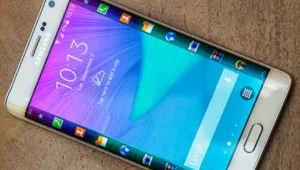Skipping its normal IFA unveiling, Samsung held its Galaxy Unpacked event in mid-August to show off its newest flagship smartphones. It is thought that the earlier announcement was to ‘steal a march’ on Apple’s next iPhone, which is due to be announced on 9th September.
The Galaxy S6 Edge+ is a 5.7″ smartphone, using Samsung’s curved display design that was seen on last year’s S6 Edge. The Galaxy Note 5, with its stylus, is more of a prosumer model.
At the same time as its new smartphones, Samsung launched its own wireless payment system to rival Apple Pay: the innovatively-named Samsung Pay. Protected by the company’s Knox security system, fingerprint verification and ‘digital tokenisation’, the technology works with both magnetic secure transmission and NFC. It will be launched in South Korea and the USA.
Built with a metal chassis, the S6 Edge+ features a curved AMOLED display (2560 x 1440). A new feature, ‘Apps Edge’, provides access to favourite apps with a swipe of the side display, while ‘People Edge’ enables fast access to communications with close contacts. A six-month subscription to Google Play Music is also included for customers purchasing before the end of September.
The camera is a highlight of the S6 Edge+. Samsung has built in features such as digital video image stabilisation on front and rear cameras, and ‘video collage mode’, to record and edit short videos quickly and easily. The smartphone supports filming in UltraHD resolution, as well as Live Broadcast; this is used to livestream 1920 x 1080 video to an individual, group or the public through YouTube Live.
Wireless and fast charging (to full charge in 90 minutes via wired or 120 minutes via wireless) are built in. Additionally the product supports Samsung’s Sidesync, which os designed to synchronise files between PCs and mobile devices. Other technologies include the Knox security system and real-time HDR photography.
Samsung’s Note 5 is an iteration on the Note series. The S Pen is bundled with the device, enabling features such as hover and annotations. Aside from the S Pen – and the flat screen – it is identical to the S6 Edge+.
Both smartphones have a 5.7″ AMOLED screen, and run Android 5.1 on a 64-bit, octa-core processor (four cores at 2.1GHz, four at 1.9GHz), with 4GB of RAM. They feature 4G connectivity, 16MP/5MP rear/front cameras and a 3,000mAh battery.
Pricing has not been announced yet. The S6 Edge+ will be launched worldwide this month, while the Note 5 will initially be limited to the USA. 32GB and 64GB variants of both units will be available.
Analyst Comment
We knew about Samsung’s earlier launch date thanks to the Wall Street Journal (Note 5 Will Precede IFA). It makes sense, as the phone will be on the market before Apple’s iPhone – as opposed to several weeks afterwards, as was the case with last year’s models.
Unfortunately, while Samsung may have stolen a march on its US rival with the earlier launch, it is late to the mobile payments scene – a factor likely to tell in at least the first months. Apple Pay is already established in the USA, while Google is rebranding its Google Wallet to ‘Android Pay’. The presence of another mobile payment system, from a major player, in the Android ecosystem may confuse consumers. Samsung also has no pre-saved card information, as Apple did with iTunes.
The USP for Samsung Pay, and the feature that is likely to boost its adoption, is its compatibility with existing magnetic stripe card readers. Samsung says that Samsung Pay will be accepted at more than 10 million locations in the USA, compared to Apple Pay’s 1 million. IHS points out that this advantage will gradually disappear as POS terminals in the USA are migrating to a chip-and-PIN system by October (Europe is already mostly chip-and-PIN).
In related news, a filing for several trademarks in the USA implies that LG is preparing to challenge Samsung’s curved phones with its own product.. Trademarked names include G Edge, Super Edge, Dual Edge, Double Edge and Dual Side Edge.
LG already has a curved phone (the G Flex family), but these new trademarks suggest a device curved on the sides, rather than up the middle. Of course, LG Display showed a prototype OLED panel at CES this year with curved edges; the unit had 1280 x 720 resolution and 300 cd/m² of brightness (TA).

